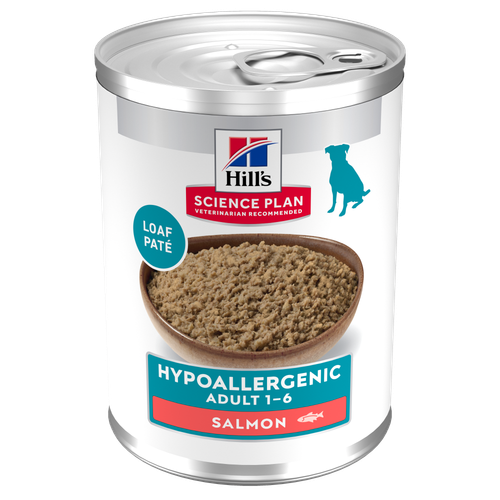
-
Find the right food for your petTake this quiz to see which food may be the best for your furry friend.Find the right food for your petTake this quiz to see which food may be the best for your furry friend.Featured products
 Puppy Food
Puppy FoodHill's Science Plan Puppy Multipack Wet Dog Food with Chicken & Beef are complete premium pet foods for growing puppies from weaning until 1 year old and for pregnant and nursing dogs. Your puppy will love these deliciously smooth and savoury minced loaves, formulated for balanced nutrition and overall health.
Shop Now Mature Adult Dog Food
Mature Adult Dog FoodHill's Science Plan Mature Adult Multipack Wet Dog Food with Chicken & Beef are complete premium pet foods for mature adult dogs from 7 years. Your dog will love these deliciously smooth and savoury minced loaves, formulated to deliver the appropriate amount of energy to support the needs of adult dogs.
Shop Now Adult Wet Dog Food with Beef
Adult Wet Dog Food with BeefHill's Science Plan Adult Multipack Wet Dog Food with Chicken, Beef & Turkey are complete premium pet foods for adult dogs from 1 year. Your dog will love these deliciously smooth and savoury minced loaves, formulated for balanced nutrition and overall health.
Shop NowFeatured products Sensitive Stomach & Skin Adult Cat Food
Sensitive Stomach & Skin Adult Cat FoodHill's Science Plan Sensitive Stomach & Skin Adult Wet Cat Food with Turkey is a complete pet food for adult cats, aged 1–6 years. This highly digestible wet food comes in a pouch and supports healthy digestion, as well as nourishes skin and promotes a thick and lustrous coat.
Shop Now Hairball & Perfect Coat Adult Dry Cat Food with Chicken
Hairball & Perfect Coat Adult Dry Cat Food with ChickenHill's Science Plan Hairball & Perfect Coat Adult Cat Food with Chicken is formulated to effectively help avoid hairball formation in adult cats while promoting a beautiful coat. Thanks to its mix of essential omega-6 fatty acids, this food benefits the cat's skin and fur, keeping them healthy and shiny. Our Advanced Fibre Technology helps reduce hairballs by naturally promoting their passage through the gut. This food is formulated with high-quality protein for a perfectly balanced, great-tasting recipe.
Shop Now Sterilised Adult Cat Food
Sterilised Adult Cat FoodHill's Science Plan Adult Sterilised Cat Dry Food with Salmon is specially formulated with ActivBiome+ Multi-Benefit Technology. It is a precisely balanced nutrition, tailored to meet the needs of sterilised cats, to help keep them lean & healthy.
Shop Now -
Dog
- Dog Tips & Articles
-
Health Category
- Weight
- Food & Environmental Sensitivities
- Urinary
- Digestive
- Joint
- Kidney
-
Life Stage
- Puppy Nutrition
- Adult Nutrition
- Senior Nutrition
Cat- Cat Tips & Articles
-
Health Category
- Weight
- Skin & Food Sensitivities
- Urinary
- Digestive
- Kidney
-
Life Stage
- Kitten Nutrition
- Adult Nutrition
Featured articles Show some love with wet foods: a great choice for pets with health issues
Show some love with wet foods: a great choice for pets with health issuesShow some love with wet foods: a great choice for pets with health issues.
Read More The Right Diet For Your Pet
The Right Diet For Your PetIn people, the right diet is very important. If you are eating the wrong way for your metabolism, activity level, age and lifestyle you could end up with health issues.
Read More Help! My Dog Doesn't Like Me & I Have a Standoffish Cat
Help! My Dog Doesn't Like Me & I Have a Standoffish CatIf you've ever thought to yourself, "My dog doesn't like me," or "Why do I have such a standoffish cat?" rest assured that you aren't the only pet parent who has these concerns.
Read More -


Is your dog licking and scratching incessantly? Are they starting to lose their fur? If so, they might have mange. While a number of conditions could be responsible for your dog's itching, it's important to arm yourself with the facts about dog mange. Mange is a condition that, while usually treatable, is sometimes contagious and has the potential to be serious. Keep reading to learn about mange in dogs and how you can help your itchy dog.
What Is Mange?
Generally speaking, mange is a skin condition caused by an infestation of mites. These are tiny parasitic arachnids that are closely related to ticks. There are three major types of mange that affect dogs: demodectic mange, which is not contagious, and sarcoptic mange and cheyletiella, which are both contagious to dogs as well as humans.

Demodectic mange
This type of mange is caused by infestations of Demodex mites, which live in your dog's skin and hair follicles.
Demodex mites can be found in small numbers in dogs and humans, but are usually kept in check by the immune system. Demodectic mange develops when the immune system can’t stop the mites from reproducing, at which point the growing number of mites starts to cause hair loss and itching.
This can happen in dogs with a weakened immune system, such as those with some cancers and infections, or simply because the dog is young and their immune system is still developing. There are some breeds of dog, such as Staffordshire and English bull terriers, that are genetically predisposed to demodex, possibly because their genetic makeup has caused a weakened immune system.
With all this in mind you can see why demodex tends to affect dogs that are sick, geriatric dogs, young puppies and certain breeds.
Although demodectic mange is not normally contagious, mothers can pass it to their puppies due to the very close contact they have. While any puppy can catch demodex in this way, the puppies of predisposed breeds tend to be the ones that succumb to mange.
Demodex is usually quite easily treated, but this will also depend on whether any underlying medical problem can also be resolved.
Sarcoptic mange
This type of mange is caused by the Sarcoptes scabiei mite — the same mite that causes scabies in humans. These mites burrow under the skin, causing extreme itching. Hair loss from this type of mange is usually the result of a dog's incessant scratching and chewing, rather than the mange itself.
While sarcoptic mange is treatable, it's highly contagious and transmissible to humans and other pets. If your dog is diagnosed with this kind of mange, keep a close eye on yourself and the family. Look for patches of itchy skin and let your doctor know that your dog has sarcoptic mange.
Cheyletiella mites
An infestation with this mite is often called ‘walking dandruff’ because that’s exactly what it looks like! These mites rarely cause itching in the early stages but if the infestation goes unchecked you could see redness, itching and hair loss. If you notice itchy skin on yourself, again, notify your doctor of your dog’s diagnosis.


Tasty Tips
Signs and Symptoms of Mange in Dogs
Signs that your dog could be suffering from mange include:
- Redness, rash, and itching
- Hair loss
- Sores and lesions
- Scabby, crusty or scaly skin
While all types of mange can cause itching and hair loss, they do tend to affect slightly different areas. Cheyletiella tends to look like dandruff, usually along the back. Demodex tends to cause hair loss first on the head and legs, while Sarcoptes love armpits (axillae) and ear flaps (pinnae). Although it’s not set in stone, these differences may give your vet some good clues as to where to start looking.
Diagnosing Dog Mange
Your veterinarian may perform a number of tests, usually starting with skin scrapes and hair plucks. Other tests may include blood and urine tests to rule out alternative causes of your dog's itching and hair loss, such as allergies or metabolic disorders.
Treating Dog Mange
Treatments for mange vary depending on the type.
Treating Sarcoptic Mange
In times gone by, treating all mange was difficult and involved repeated, strong chemical washes that were no fun for anyone. Luckily, these days there are various spot-ons and oral medications that quickly and effectively cure most Sarcoptes infestations.
Treating Demodectic Mange
A localised Demodex infestation, where there are just one or two patches, usually gets better on its own and doesn’t need treatment. However, if your dog has a weakened immune system, they may develop generalised demodicosis, which can be much harder to clear up. Your vet may also want to do various tests to try to find out why your dog may have succumbed. Again, modern treatments are more simple than before, but your vet may want to do a combination of treatments for severe infestations.
Treating Cheyletiella
These mites usually respond well to medicated shampoos. You may need to repeat the washes a few times to kill newly hatching mites. There are also several sprays and spot-on treatments that treat ‘walking dandruff’.
Your vet will be able to guide you to the most effective and appropriate treatment for your dog, depending on what sort of mite they have.
Don’t worry…
The word mange often conjures up images of dirty, neglected animals. Just like children getting head lice, dogs picking up parasites is just a fact of life. It’s not a reflection on you as an owner.
If you notice your dog itching, gnawing and losing fur, book in a vet visit as soon as you can. As with everything, the earlier you catch it, the more likely it is that you can nip it in the bud. Sometimes mange can be a pointer that something deeper is going on and those little creatures may just give you and your vet the chance to catch a much bigger issue before it causes more problems. Always look on the bright side of life – even mange can be a positive!


Jean Marie Bauhaus is a pet parent, pet blogger, and novelist from Tulsa, Oklahoma, where she usually writes under the supervision of a lapful of fur babies.
Related products

Hill's Science Plan Puppy Multipack Wet Dog Food with Chicken & Beef are complete premium pet foods for growing puppies from weaning until 1 year old and for pregnant and nursing dogs. Your puppy will love these deliciously smooth and savoury minced loaves, formulated for balanced nutrition and overall health.

Hill's Science Plan Adult Multipack Wet Dog Food with Chicken, Beef & Turkey are complete premium pet foods for adult dogs from 1 year. Your dog will love these deliciously smooth and savoury minced loaves, formulated for balanced nutrition and overall health.

Hill's Science Plan Hypoallergenic Adult Wet Dog Food with Salmon is a complete premium pet food for all adult dogs from 1 year. This savoury tinned loaf is specially formulated for dogs with delicate skin and stomachs. It features a single novel animal protein source and is grain-free.

Hill's Science Plan Mature Adult Multipack Wet Dog Food with Chicken & Beef are complete premium pet foods for mature adult dogs from 7 years. Your dog will love these deliciously smooth and savoury minced loaves, formulated to deliver the appropriate amount of energy to support the needs of adult dogs.
Related articles

Discover the causes, signs, and treatments of kidney disease in dogs and find methods of supporting your dog's kidney health. Learn more at Hill's Pet UK.

Understand the potential causes of excessive dog itching and how to address them. Seek relief for your dog with expert advice from Hill's Pet UK.

Just like every other pet owner, vets are responsible for giving their pets the best possible nutrition, exercise and care needed to keep them healthy and happy.

Dog obesity is a significant problem - learn more about helping your dog become trimmer and healthier through improved nutrition.

Put your dog on a diet without them knowing
Our low calorie formula helps you control your dog's weight. It's packed with high-quality protein for building lean muscles, and made with purposeful ingredients for a flavourful, nutritious meal. Clinically proven antioxidants, Vitamin C+E, help promote a healthy immune system.
Put your dog on a diet without them knowing
Our low calorie formula helps you control your dog's weight. It's packed with high-quality protein for building lean muscles, and made with purposeful ingredients for a flavourful, nutritious meal. Clinically proven antioxidants, Vitamin C+E, help promote a healthy immune system.

